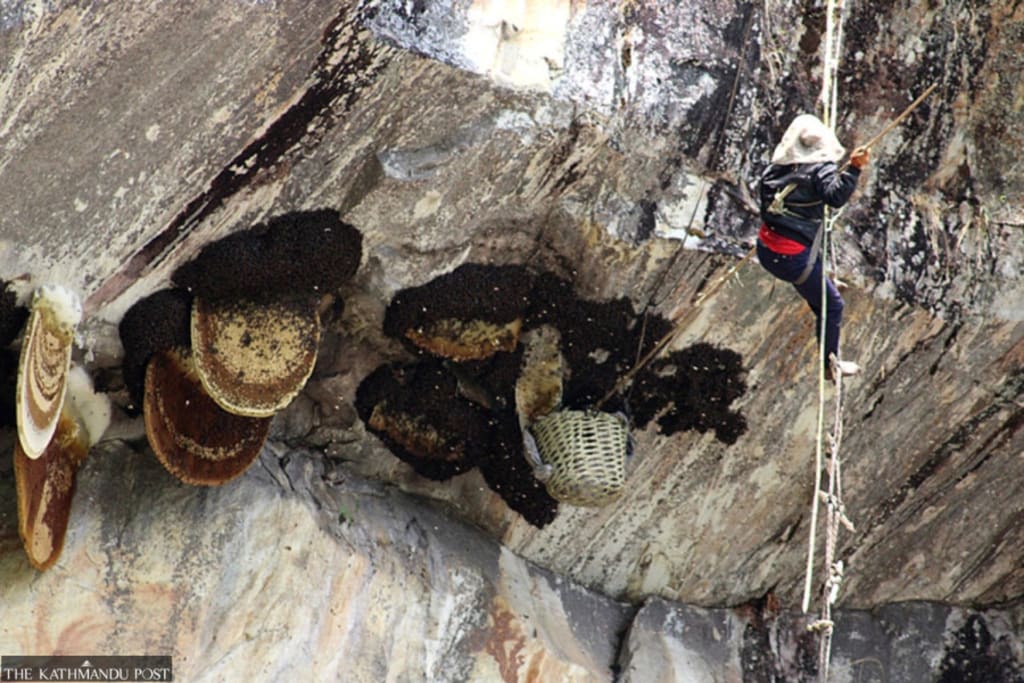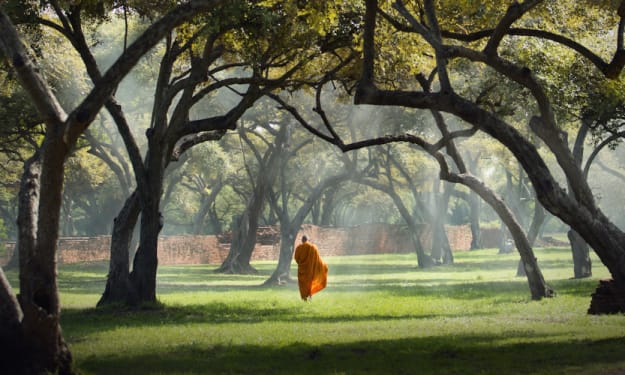
Dambar Bahadur Gurung sits on a bank of the Nimrung stream in Gorkha, his eyes trained on his son Surya Bahadur, who is hanging off the cliffside of a treacherous rockface. Surya Bahadur is concentrating on breaking a beehive jutting out of the rock. The 77-year-old father’s face lights up with pride as he observes his son deftly breaking off the hives of the wild bees dangling on a rope in the middle of a narrow opening at the top of the cliff.
Meanwhile, Surya Bahadur’s son Dhanraj, standing at the bottom of the cliff, ensures that the rope holding his father high up stays tight, as he observes his father, taking notes on the art of honey harvesting.
Dambar Bahadur, a resident of Khorla village in Gorkha’s Dharche Rural Municipality, learned the art of harvesting honey from his father Kumsingh. Dambar Bahadur is famous locally as the ‘king of honey hunting’. His family’s legacy of hunting honey at the cliffs towering over the Nimrung stream, a well-known habitat for wild bees, goes back seven generations.
The prominent species of wild bee in the Kaski region in central Nepal is the Himalayan cliff bee (Apis laboriosa).
“I have been harvesting honey from these cliffsides for 50 years. Earlier, during the honey hunting season, you would see me hanging off a cliff but these days you will see me here at the bottom of the cliff watching my son take on the mantle or on the streambanks teaching my grandsons the craft,” said Dambar Bahadur.
Locals from Uhia, Khorla, Laprak, Halchok and other villages of Dharche Rural Municipality, where the tradition of collecting honey from wild bees has been practised for decades, go to the forests in search of hives as soon as the season starts. The hunters determine the day to harvest honey. Their experienced eyes can tell when a hive is ready for harvest, says Dambar Bahadur. “Hunters can tell by just looking at the honeycombs whether it is harvest time or not. This year’s honey hunting began at Nimrung stream cliff on Tuesday,” he said. “The hunting season begins around May and lasts through June. The harvesting commences after checking for honey drips outside the hive.”
Honey hunters, including his son, and their helpers from the area do not begin their journey to the top of the cliffside without first listening to Dambar Bahadur’s instructions.
With the start of the honey collection season, Surya Bahadur, who has been a honey hunter for a decade now, takes a break from livestock farming and renting mules. On Tuesday, Surya Bahadur could be seen clinging precariously to a rope ladder making his way upward one rung at a time. Another rope goes around his waist hoisting him up and securing him.
Underscoring the dangers of this undertaking, Surya Bahadur says mental fitness is equally important as physical fitness to become a successful honey hunter. “It is imperative to have a clear mind when undertaking this task. If your mind is disturbed and you lose focus, you will not be able to maintain physical balance,” he said. “A minor slip could mean falling hundreds of feet towards your death. One must also be prepared for bee stings for it can be dangerous in some cases. While some get away with minor swelling and localised irritation, others may suffer from severe allergic reactions.”
Dhanraj, Surya Bahadur’s 21-year-old son, arrived in the village a week ago from Kolkata, India for the honey hunting season. An Indian Army soldier, Dhanraj says he is using his vacation to learn the art of honey hunting from his father and grandfather.
“I had some vacation time, so I thought I would use this time to learn honey-hunting skills. One needs both strength and knowledge to harvest honey. I have a long way to go before I become a skilled hunter. At present, I am learning how to hold a rope and cut the honeycomb,” said Dhanraj, who has taken a ‘mountain course’ during his army training where he was taught rope climbing. “It is all about one’s interest. As a child, I remember being fascinated by listening to my grandfather and father sharing their honey-hunting stories. I am inclined to learn this skill from them and teach it to our children in the future.”
Seventy-year-old Sun Bahadur Gurung assisted Dambar Bahadur in harvesting honey from the cliff sides for around four decades. On Tuesday, Sun Bahadur had also reached Nimrung stream to watch this season’s honey hunting.
“I have been helping honey hunters since I was 25 years old”, Sun Bahadur said. “Now I am old and my strength has declined so I have stopped assisting the hunters. But it fills my heart to see the new generation taking up the task.”
This year, a week before the honey harvest, the locals were busy preparing ropes, which are essential in building ladders used to climb the cliff face. They also prepared wooden sticks to poke the beehives and managed the materials needed to smoke out the bees.
A village messenger had informed the whole village of the commencement of the honey-hunting season following a village meeting on Monday.
On Tuesday, the residents of Khorla village gathered in Namrung stream where a pooja was performed as the honey hunters began their final preparations.
“Locals believe that misfortunes will strike you during honey hunting if you don’t offer worship before commencing the task,” said Dil Bahadur Gurung, a local man of Khorla.
This year, there are honeycombs at nine different cliff faces along the Nimrung stream, which is 2,200 metres above sea level.
Dil Bahadur said that the hunters will harvest honey from each cliffside continuously throughout the season.
“The honey will be harvested until mid-June,” he said.
The whole community takes part during the honey hunting season including skilled local youths, who help in fixing and securing the ropes, supply bamboo baskets to the climbers to store the honeycombs and transport the harvested honey back to the stream banks, while other villagers stay around Nimrung stream all day long to assist when needed.
Pritman Gurung, another local, says the honey-hunting season is observed as a festival in the villages.
“Everyone here has their own role, those who help the hunters also carry a huge responsibility,” said Pritman.The locals burn dry and green plants to create smoke to deter the bees from the honeycomb while others on the ground are busy extracting honey by squeezing the honeycombs harvested from the cliffsides.
Him Maya Gurung of Khorla village says after the harvest the villagers share the honey among themselves.
“Honey is also used for medicinal purposes,” she adds. “It is a regular practice for at least one member of the family to participate in honey harvesting. We, by choice, participate every year.”
According to her, one beehive produces anywhere between 1-5 litres of honey depending on the size of the hive. The honey hunters and people who assist them are normally given a bigger share of the hunt.
According to Dil Bahadur Gurung, such honey, harvested from cliffs, has traditionally been used as medicine. People who suffer from stomach ailments use honey as a cure.
It is also a common belief that feeding cliff honey to livestock helps in improving their immunity.
“Once a year, we feed the honey to our oxen. This helps them become stronger and grow fat around their necks, which results in a more efficient field ploughing,” Dil Bahadur said.
Recently, mules have also been fed honey.
Additionally, the honey is also used for personal use and as souvenirs.
Vice-chair of the Dharche Rural Municipality Sunila Gurung says that the rural municipality is also trying to boost local tourism by promoting honey hunting in the Dharche region.
“This tradition has been going on for generations and you can see the hunters harvesting honey with great risk. We are also mulling over ways to make honey hunting less risky,” she said. “We are also thinking about bringing in tourists and promoting the region as the place for cliff honey hunting.”
Even though it has been years since he climbed a rope to reach the cliffside, Dambar Bahadur’s passion for honey hunting is far from dim. “The one dangling from the cliffside is my son, Surya Bahadur,” Dambar Bahadur pointed out proudly. I live vicariously these days through my son and grandson.”
“While up there, even a small mistake can turn fatal,” he said. “My job now is to look after my son and direct him with the experience that I have gathered over the years to help him harvest the prize and get back down safely.”
About the Creator
Enjoyed the story? Support the Creator.
Subscribe for free to receive all their stories in your feed. You could also pledge your support or give them a one-off tip, letting them know you appreciate their work.





Comments
There are no comments for this story
Be the first to respond and start the conversation.